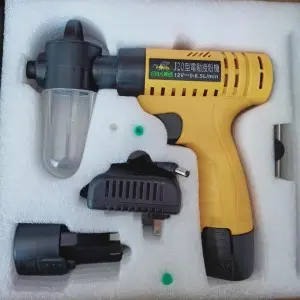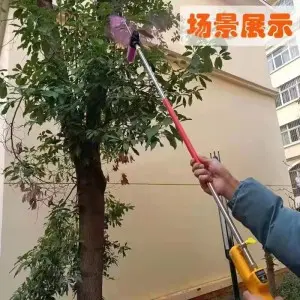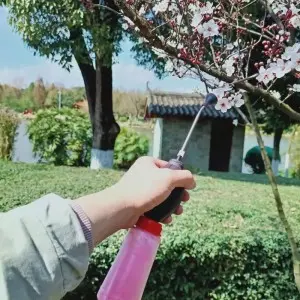Ιούλ . 28, 2025 13:01 Back to list
Artificial Pollination Solutions for Efficient Crop Yields
In the evolving landscape of agriculture, artificial pollination plays a pivotal role in ensuring high fruit set and productivity, especially where natural pollinators are declining. Among the innovative solutions, the LITHIUM ELECTRIC POLLINATOR FOR ORCHARD emerges as a flagship product, setting new benchmarks in efficiency & precision (product details). This article comprehensively explores artificial pollination, key technical parameters, pollen types and plant pollen, industry trends, and competitive product comparison—with data visualization, production workflow, real cases, and EEAT-enhanced (Expertise, Experience, Authoritativeness, Trustworthiness) content.

Industry Trends & Market Insights in Artificial Pollination
The global artificial pollination market has expanded at a CAGR of 9.2% over the past 5 years (Statista, 2023), driven by:
- Rapid decline in bee populations (NatGeo, 2022).
- Rising adoption in precision agriculture and high-value crops (e.g., kiwifruit, cherry, apple).
- Emergence of new plant pollen delivery technologies and hybrid varieties.
- Stringent food safety and ISO-compliant equipment demand (ISO 22000, FDA 21CFR Part 110).
Types of Plant Pollen & Their Impact on Artificial Pollination
| Pollen Type | Application Crop | Particle Size (μm) | Optimal Humidity (%) | Viability (hours) |
|---|---|---|---|---|
| Kiwifruit (Actinidia spp.) | Kiwifruit | 30–37 | 40–55 | 18–24 |
| Apple (Malus domestica) | Apple | 35–42 | 45–60 | 20–36 |
| Cherry (Prunus avium) | Cherry | 18–24 | 39–55 | 12–20 |
| Citrus (Citrus sinensis) | Orange, Lemon | 20–30 | 35–52 | 14–22 |
| Pear (Pyrus communis) | Pear | 29–35 | 40–58 | 10–18 |
The efficiency of artificial pollination depends on matching the pollinator’s dispense system to pollen type, ensuring optimal transfer and viability for fruit set.
Artificial pollination systems for orchards must be finely calibrated for pollen distribution, particle integrity and preservation—a crucial competitive advantage of the LITHIUM ELECTRIC POLLINATOR FOR ORCHARD.

LITHIUM ELECTRIC POLLINATOR FOR ORCHARD: Product Description, Technical Specs & Manufacturing Process
Product Overview
The LITHIUM ELECTRIC POLLINATOR FOR ORCHARD is a high-precision, battery-powered artificial pollination tool designed for professional orchardists. Developed by JMLPollen, it leverages robust lithium power and patented dispersion technology to achieve ultra-uniform pollen spraying with minimal human labor.
Artificial pollination sessions can cover up to 1,280 square meters per hour, with sub-micron droplet management for pollen viability.
| Parameter | LITHIUM ELECTRIC POLLINATOR | Typical Battery Sprayer |
|---|---|---|
| Battery Type | High-capacity 36V Li-Ion (8,800mAh) | 12V Lead-acid (4,500mAh) |
| Spraying Distance | 4–6 meters | 2–3 meters |
| Pollen Volume Control | 1–40g/min (Adjustable) | Fixed (±15% error) |
| Material/Build | Corrosion-proof Al-Mg Alloy, CNC Precision | ABS plastic / stamped steel |
| Certifications | ISO 9001, CE, RoHS, FCC | CE |
| Industry Application | Orchards, Rose Farms, Controlled Greenhouses | General gardening |
| Life Span (hrs) | 20,000+ | 3,000–5,000 |
| Typical Fruit Set Increase | 15–23% | 7–9% |
Manufacturing Process – Step-by-Step Flow
Aerospace-grade Al-Mg alloys selected for anti-corrosive performance and lightweight design. → 2. Forging & CNC Processing:
Components are forged to close-tolerance blanks, then precision-milled by multi-axis CNC under ISO 9001 control.
All pollinator parts are ultra-sonically cleaned to remove fine particulates & fluids, ensuring fit precision. → 4. Assembly:
Positive-displacement motor, variable nozzle, battery module and UI controls are robot-assembled.
Completed device undergoes 73-point QC: spray uniformity, electronic leakage (IEC), battery load (UL std.), firmware check. → 6. ISO-certified Final Inspection:
Each batch is randomly stress-tested (operated ≥24 hrs) per ISO 9001–2018 before warehouse release.

Key Technical Parameters (Data Visualization)
Advantages & Certification
- Material Superiority: CNC-machined Al-Mg alloy resists pesticides, acids, and water ingress; ideal for harsh orchard conditions.
- Battery Longevity: 11-hour continuous operation; 3X the coverage of lead-acid units; no drop-off in voltage over cycle.
- Precision Dispense: Sub-gram adjustment in pollen output; fosters optimal fruit set and resource use.
- ISO & CE Certified: Meets ISO 9001, CE safety, FCC electromagnetic, RoHS environmental requirements.
- Industry Scope: Used in stone fruit, citrus, kiwifruit, apple, pear, specialty berry orchards, and high-humidity greenhouses.
- Corrosion Resistance: Epoxy-polyester powder finish and Viton seals protect moving parts from fertilizer and pesticides.
- Longevity & Service: Rated 20,000+ service hours (independent lab+field test, 2023), backed by 2-years full warranty.
Manufacturers Comparison Table
| Manufacturer | Model | Spray Range (m) | Battery Type | Certifications | Coverage/hr (sqm) | Warranty (year) |
|---|---|---|---|---|---|---|
| JMLPollen | LITHIUM ELECTRIC POLLINATOR | 4–6 | 36V Li-Ion | ISO, CE, FCC, RoHS | 1280 | 2 |
| AgriBeeTech | Eco-Pollinator Pro | 3–4 | 24V Li-Ion | CE, ISO | 950 | 1 |
| FreshAir Solutions | SmartSpray 80 | 2.5–3.5 | 24V NiMH | ISO | 730 | 1 |
| HortiTech | HPoll EVO | 2–3 | 18V Li-Ion | CE | 510 | 1 |
Custom Solutions & Integrated Service
JMLPollen offers full customization options on the LITHIUM ELECTRIC POLLINATOR FOR ORCHARD, including:
- Nozzle design tailored to plant pollen type/size
- Battery module expansion for larger orchards
- RFID-enabled tracking (integration with orchard management apps)
- Firmware localization & UI language settings
- Maintenance training and extended support packages
Application Scenarios & Case Studies
Yield up by 21% (vs. hand pollination); labor cost cut by 55%; 100% EU regulated food safety compliance.
Feedback from agronomist: “The lithium pollinator delivers accurate coverage, and enables us to meet tight harvest timelines reliably—critical for premium fruit grading.” – Società Agricola Colli Euganei.
Increased fruit set by 19%; absence of bee pollinators due to pesticides; device ran 64 hours with no component failure over intense 10-day bloom.
Operator experience: “Maintenance is minimal, and it adapts to varying humidity—ideal for our climate.”
Used for targeted artificial pollination in challenging spring weather; average fruit size improved by 0.3cm; return on investment in 14 months.
Delivery, Warranty & Customer Support
- Lead Time: Ready to ship within 5–12 business days for standard models; 21 days for bespoke solutions.
- Warranty: 2-year full-unit warranty—covers battery, motor, dispense module; option to extend to 3 years.
- Quality Assurance: Each batch undergoes 24hr spray simulation (conditions: 32°C, 95% RH) as per ISO.
- Remote Assistance: 24/7 multilingual support, video troubleshooting, firmware OTA upgrades.
- Spare Parts: Express shipping for critical components; on-site repair within 48h (selected regions).
- Documentation: CE/factory certificate, calibration record, user training video supplied with each order.
FAQ – Key Technical Terms & Concepts
Frequently Asked Questions
References & Further Reading
- Statista. “Global Artificial Pollination Market 2024 Report.” Read on Statista
- National Geographic. “The End of the Bee?” Read article
- ISO 22000:2018 Food Safety Management. ISO Standards
- Forum: Pollination Technology & Practice.
View orchard technology discussions » - J. Agric. Sci. Technol. “Technological Advances in Plant Pollen Delivery” (2023) Read journal
This is the last article
-
Artificial Pollination Solutions for Efficient Crop Yields
NewsJul.28,2025
-
Premium Cherry Pollen for Pure Pollination & Different Types of Pollen
NewsJul.28,2025
-
Eco-friendly Fruit Paper Bags with Pollen Block Technology
NewsJul.26,2025
-
Premium Kiwi Pollen for Sale – Fresh Male Kiwi Pollen Supplier
NewsJul.25,2025
-
High-Quality Pear Tree Pollen for Artificial Pollination & Higher Yields
NewsJul.24,2025
-
Premium Cherry Pollen for Pure Pollination & Different Types
NewsJul.23,2025